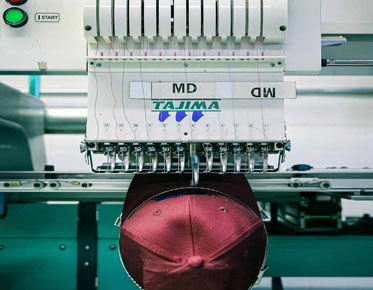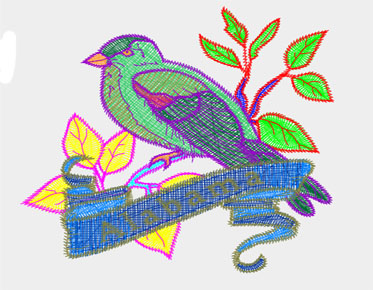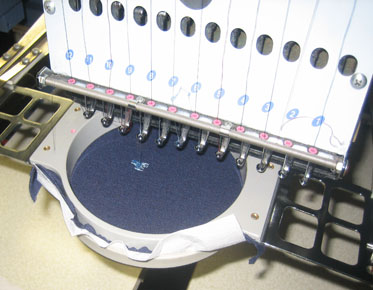Learn from Eagle digitizing to Embroider A Hat | Complete Guide
Ever gotten embroidery digitizing on caps? In fact, it's one of the most popular ways of making money from an embroidery business. Caps are used in sports and fashion, which makes them a staple in the industry and create more opportunities for your creativity. Why not take the time to learn how to design on them for both fun and profit?
If you want to embroidery on caps and beanies, the process is relatively similar. However, remember that since the stitching will be close to the head, you may need to add additional space for the fabric and threads to move around.
How To Embroider Cap Hats
It stands to reason that when embroidering on caps, there would be a variety of placement options. Some options are limited to being embroidered before the manufacturing process (example: the bill). But there are plenty of options for an embroiderer to consider. Most multi-needle embroidery machines can handle the front, both sides, the back of the cap, and even most places in between.
The most common area embroidered is the front of caps. Even the most basic cap frames are designed to do the front of caps. Today, most commercial embroidery machines utilize wide angle cap frames designed to go most of the way around the cap, typically 270º of rotation. This will handle not only the front of the caps but also the sides. That leaves the back for which most embroiderers use a traditional round hoop.
Here we want to look at each location and see what needs to be done for the best results. While the cap’s makeup does play a big part in how each cap is framed, the basic principles will work regardless of the type of cap. Let’s start with the front and center.
Machine embroidering the front and center of hats
The front of a cap is the most common placement and probably the easiest placement to sew. As mentioned, all cap frames are designed to embroider the front of the cap, if nothing else. The main variance with ball caps is whether or not the front panels are structured or not. Structured caps typically have a fused buckram backing inside, making the crown of the cap stand up. Unstructured (varsity & collegiate style hats) do not have this and tend to be more floppy.
For unstructured caps, it’s important to use cap backing (stabilizer). Cap backing is a stiff and heavy tear away. It provides stabilization for the fabric for unstructured caps and helps hold the shape of the cap while it’s embroidered. Structured caps don’t need the backing as the fused buckram acts as the stabilizer.
Then you have some in-between styles like soft buckram or even foam-backed caps. For caps like these, using a piece of cap backing is recommended and yields excellent results.
When doing front only placements on structured caps, it’s not always necessary to put the back clip on the frame of wide-angle caps frames. In fact, for larger designs, it’s often advantageous to leave the back clip off for these types of caps. It gives a little flexibility to the cap and prevents distortion of the design at the top of the design.
Machine embroidering the side of hats
For side placements, you must utilize the back clip. The primary purpose of the back clip(s) is for side placements on caps. Wide-angle cap frames vary from brand to brand. The main difference is the back clips, as some have one large clip or one on each side of the back. Most brands use multiple clips that look a lot like binder clips from an office supply store. Whatever the type of clip, it’s important to use them when sewing side placements on caps. Otherwise, the design will look like it’s running downhill.
While cap backing may be optional for front placements on certain caps, it’s a necessity for side placements. There is no fused buckram on the sides of caps and, therefore, must be stabilized. For normal twill caps, a single piece of cap backing will work just fine.
The same goes for a mesh cap. Yes, it’s possible to sew on mesh caps with the proper stabilization. The backing provides the necessary material to hold the stitches together. For this reason, we recommend a cutaway stabilizer.
It can sometimes be tricky to get the backing to stay in place on the side while hooping the cap. The tendency would be to tuck it under the frame. While that holds it in place while on the framing device, the backing will fall right out afterward as it is not being held in place by the frame. The cap has to be hooped with the backing on top of the frame.
One way to overcome this hassle is by placing a piece of double-sided tape (such as carpet tape found at most home improvement stores) on the side of the cap frame. Then peel the backing paper off and stick the cap backing onto the tape. This will secure the hold the backing in place long enough to get the cap hooped but pulls off easily from the frame.
Embroidering the back of hats
Placements on the back of caps are relatively straightforward. There are several attachments on the market to assist with this placement, but a simple solution to cap back is to use a conventional small round hoop. Most machines come with a 12cm or 4.5 round hoop, which is the perfect size to fit the back of a cap, especially those with openings. The back of a cap can be hooped on a table corner if necessary, eliminating the need for any special hooping devices.
To align the back, use the marks that are typically molded into the hoop. The center seam aligns with the marks at 12 and 6 o’clock. The edge of the opening aligns with the other marks.
To stabilize the back, be sure the piece of backing covers the entire hoop. The cap back will not cover the whole hoop, but it needs to cover the whole hoop for the backing to provide great stabilization.
How to Hoop Cap Hats for Embroidery
To start embroidering on your hats and caps, they will need to be hooped properly. Whether you’re new to embroidery or an experienced embroiderer, I’m sure we can all agree that hooping caps can be difficult, especially without proper instructions. I frequently see people post about their failed embroidery hat projects, asking what went wrong, and often end up blaming their machines. Little do they know that if their cap isn’t hooped correctly, it can lead to disastrous results. As with any embroidery project, if your hooping isn’t clean, your embroidery won’t be either.
Let’s go over a hooping technique for caps/hats that the Embroidery Legacy used on our caps while running two of North America’s largest embroidery production factories in the 1990s. Follow these steps to ensure your cap is hooped properly. Before we get started, it’s important to understand that you will need a cap hooping accessory. This accessory consists of 3 main components:
Driver: the driver fits right over the top
of the arm of the machine.
Cap frame: the cap frame is what your hat
will be attached to.
Jig: the jig attaches the cap frame for more accurate hooping.
How to hoop your hat:
Step 1: Making sure your cap frame is properly secured to the jig. You will know it’s secure because it will click into place and will have no, to hardly any, wiggle room.
Step 2: We want to get the cap frame into position for our hat. We’ll start by moving the peak mount out of position as well as the band.
Step 3: Now that the jig is ready for hooping, we need to prepare the hat itself. We’ll start by moving the band on the inside of the cap out of the way, as the band will be placed underneath the plate on the jig. (Be sure to try and align the red line to the center seam)
Step 4: As our hat is on the cap frame and the band of our hat is securely in place, we’re going to take the cap frame band/strap and secure it so the teeth of the band lines up to the base of our cap. Once in position, push the strap down to lock it. Be sure there is no excess space where the peak of the hat meets the crown.
Step 5: For our final step, we’re going to start by placing material over the peak of the hat to avoid unwanted markings on our cap (hats are generally one of the hardest materials to get hoop burn out of). Once the material is in place simply engage the peak mount to ensure the peak of the hat won’t hit the machine while it’s embroidering.
Always remember, a hat needs to be hooped properly to run successfully on a machine. But what is equally or even more important is that the embroidery design is digitized specifically knowing that it will be embroidered on a curved surface.
Designs need to be digitized specifically
for caps for best results. Most experienced digitizers will take into account a
design that is size friendly for a finished hat and digitize it accordingly.



